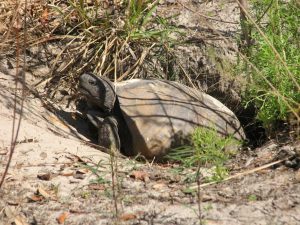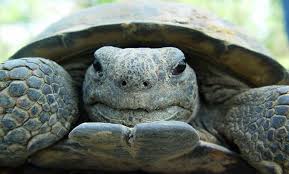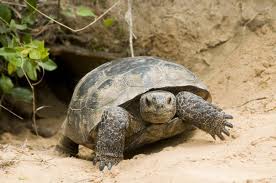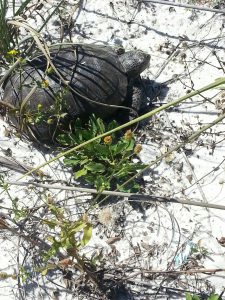This blog will wrap up our series on Florida turtles for the Year of the Turtle (2020) – and we end with a good one – the gopher tortoise. We only have two true terrestrial species of turtles in Florida, and it does not get more terrestrial than the gopher tortoise.

Gopher tortoises are long-lived, protected by their thick shells and deep burrows. Photo credit: Carrie Stevenson, UF IFAS Extension
“Gophers” (Gopherus polyphemus) are well known to many ole timers because they like the same type of habitat the earlier settlers did – high dry ground. They are indigenous to the southeast United States and prefer the open canopy of pine forest habitat. As a kid our home was on such a place in an area of Pensacola called Scenic Heights. Our house was on a “sand hill” that had pine and turkey oak trees. There were a variety of grasses and legumes growing everywhere and the soil was very dry and sandy. And we had gopher tortoise. The famous 18th century traveler/botanist, William Bartram, described this animal several times during his travels across the southeast as he crossed “sand hills” within the massive expanse of pine forest that were here at that time.
Though a forest, the longleaf pine forest of the southeast had a more open canopy allowing the growth of a variety of grasses to do well on the forest floor – as they did at my house. Tortoises are vegetarians, eating a variety of these grasses, flowers, and ground fruit. They like the young tender shoots of these plants and they were maintained those decades ago by natural wildfires started by lighting. The small fires would burn the large, tough plants down, providing the young tender shoots the tortoises prefer.
If you see a tortoise, you will notice the large square shaped shell and the elephant-like feet – definitely not a water turtle. They dig burrows in this sandy soil in which they can live during the hot days of summer and the cold days of winter. These burrows can be quite extensive – reaching a length of over 15 feet and a depth of up to 7 feet from the surface. Though the literature will tell you that they prefer dry sandy soils for digging, they have been found digging in the red clay of the southeast as well. However, these burrows are generally not as deep because the O2 levels decline and the CO2 concentrations increase significantly in clay soils. There is only one entrance to the burrow, and it has been said that gophers can dig down – but not up.
It is generally one tortoise to a burrow, but some will dig a second burrow within their range as a “back-up” during pop up thunderstorms and such. It is not uncommon to find 2-3 tortoises sharing he entrance of a burrow during stressful moments – or during mating of course. The temperatures within are nice a cool during the summer – ranging from 60 – 72°F. This “air conditioned” hide away has become popular with many other creatures of the pine forest. Over 350 species of them have been known to share the burrow. Most of these are insects but a few vertebrates are known to call including – the gopher frog, mice, the endangered eastern indigo snake, and the eastern diamondback rattlesnake. Most of these animals use the burrow during extreme conditions – heavy rain, intense heat or cold, or during a forest fire. The rattlesnakes tend to sit near the entrance and so observers should beware of sticking their face or hand into the opening looking for a turtle. Many field workers will use a small hand mirror to look into the opening. Either you see the rattlesnake, or, the reflection of sunlight into the burrow will cause the snake to rattle – altering you they are there.
Terrestrial turtles produce fewer young than aquatic species. Gophers will typically produce 5-9 eggs once a year. The eggs are usually buried within the “apron” of the burrow – this is the field of sand discarded while digging. There is a projection from the anterior end of the plastron called a gular. This projection is much longer in males and can be used in jousting matches with other males. Males will also have a concave depression from the midpoint to the posterior end of the plastron. Though mating can occur any time of year – most activity is from May to July.
These animals have declined across their range. They have the typical turtle egg raiders (raccoons, fox, skunks, and opossums) but now have threats from invasive species such as tegus and fire ants. Hatchlings and juveniles have soft shells and are easy targets. Coyotes have been seen hiding behind burrows flipping the emerging tortoise and then consuming it. However, man has been a problem as well.
Food was one problem, and apparently still is in some parts of the south. These animals were “noosed” from their burrows and cooked. During the depression era they were known as “Hoover’s Chicken”. As mentioned at the beginning – they live where we want to live. Construction crews come in and cover “entomb” them during development projects. It is now against Florida law and crews must relocate them.
In natural areas, the suppression of natural wildfires as altered the ecology enough that food for the gophers has become an issue. As they abandon their burrows seeking better spots, they are preyed upon, run over by cars, attacked by dogs, the list goes on. In recent years, an upper respiratory tract disease has proven to be common and deadly.
Today the animal is federally protected in Louisiana, Mississippi, and western Alabama. It is species of concern throughout its range and is a state threatened species in Florida. You cannot possess this animal but having one move into your yard is fine.

This gopher tortoise was found in a dune field; a place where they have historically been found.
Photo: DJ Zemenick
I hope you enjoyed this series on Florida turtles, during the YEAR OF THE TURTLE. You can find more blogs on other species by visiting the natural resource page of the Escambia County Extension website and type in which species you are looking for in the “what can we help you with?” search tool at the top of the page. https://sfyl.ifas.ufl.edu/escambia/?topic=natural-resources#county-feed.
I hope you are lucky enough to find all 25 species in the wild.
- Rattlesnakes on Our Barrier Islands; Part 4 – Thermoregulation - December 29, 2025
- Rattlesnakes on Our Barrier Islands; Part 3 – Envenomation - December 22, 2025
- St. Joe Red Tide Claiming Terrapins - December 15, 2025


